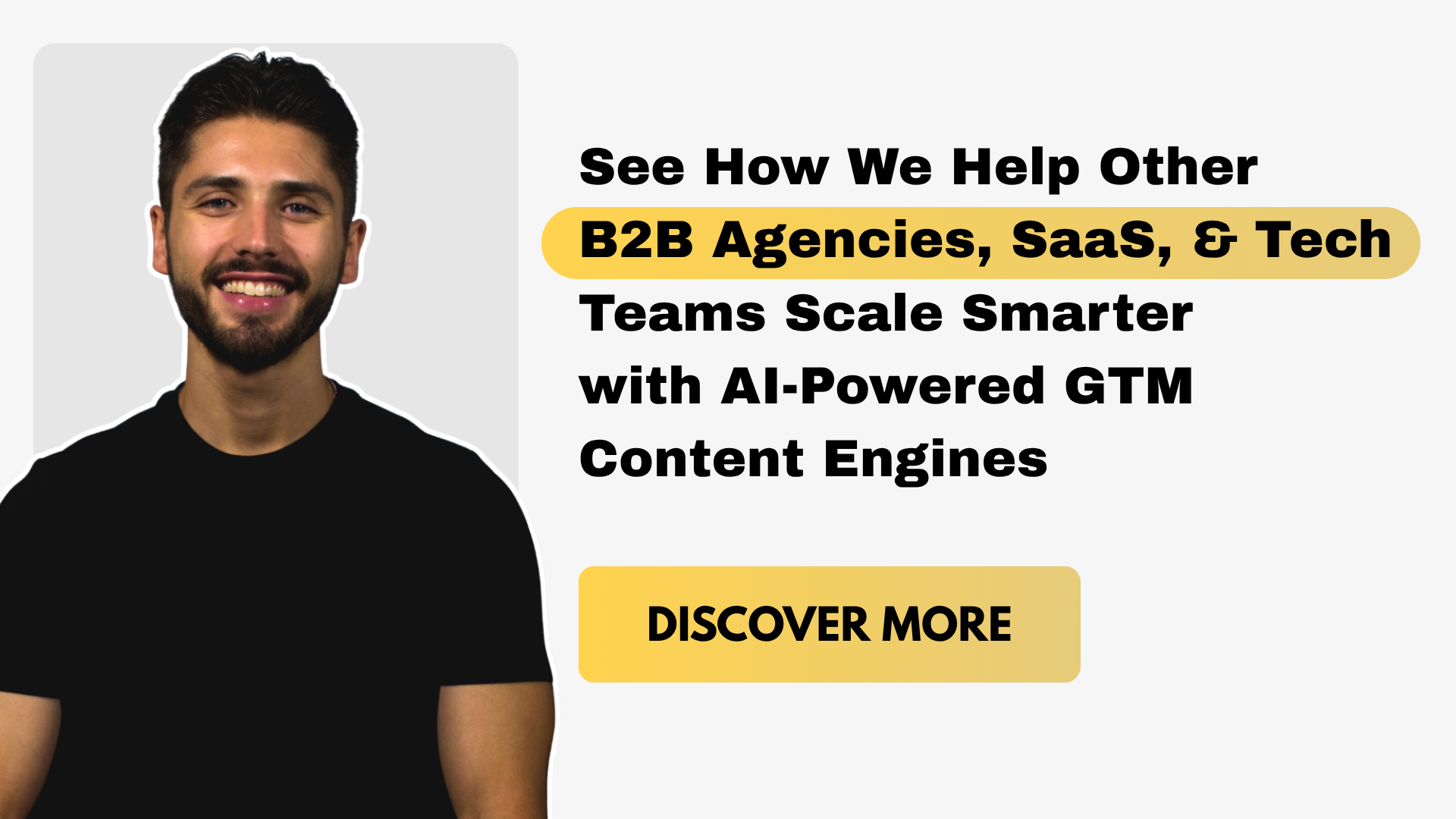The Future of AI Content Marketing in B2B SaaS
Key takeaways
AI is obliterating content inefficiencies—and exposing which teams actually know their buyer. Content that's designed for decisions, not just discovery, will dominate. SaaS companies that elevate content into their GTM strategy will outperform those who treat it as mere collateral. And at Hyve, our GTM Content Engine turns your internal IP and founder insight into pipeline-producing assets that compound over time.
Table of contents
Introduction: The Death of Traditional Content Marketing
Why AI is Rewriting the SaaS Content Playbook
How Buyer Behavior is Forcing a Content Evolution
The Rise of Content as a Revenue Engine
What AI-Driven Content Systems Look Like
Real-World Example: AI-Optimized Content in Action
The Hyve Solution: Your GTM Content Engine
Conclusion: Content is Still King—But Only If You Evolve
FAQs
Introduction
Let’s not sugarcoat it: most SaaS content today is painfully irrelevant. It’s bloated with buzzwords, lacks conviction, and completely ignores the reality of how modern B2B buyers actually make decisions. Teams are still publishing SEO blogs like it’s 2014—optimizing for traffic instead of transformation.
But traffic doesn’t close deals. Clarity does. Trust does. And most importantly, insight does.
The real issue? Traditional content marketing has become a tactical afterthought instead of a strategic growth lever. This blog will challenge that. We’ll unpack the future of AI content marketing in B2B SaaS—one that doesn’t chase keywords but creates buyers.
Why AI is Rewriting the SaaS Content Playbook
For the first time in history, your content isn't just competing with your category—it’s competing with the internet itself.
Buyers now consult AI tools like ChatGPT, Gemini, and Perplexity before ever landing on your website. These tools don’t just list sources—they synthesize answers, drawing from what they interpret as clear, credible content.
This is why traditional SaaS content marketing approaches are collapsing. They weren’t built for AI environments. Ranking on Google alone no longer guarantees attention. To remain visible, your B2B SaaS content marketing strategy must evolve to meet the AI-first expectations of your buyers.
Content must now be formatted and framed for LLM interpretation. Structure beats backlinks. Perspective trumps length. Authority isn’t built through traffic—it’s built through citation.
Welcome to the new rules of content strategy for SaaS—where relevance is judged by machine logic and buyer clarity.
How Buyer Behavior is Forcing a Content Evolution
Today’s SaaS buyers are overloaded with tools, vendors, and noise. What they need isn’t more content—it’s better logic. They want proof of outcomes, clarity on differentiation, and strategic reasoning that connects the dots.
That means your content can’t just talk about your product. It needs to anticipate the internal conversations your buyer is having: Can this help me hit my metrics faster? Is this better than our existing tool? Will this be easy to get buy-in for?
Your B2B SaaS content marketing needs to reflect real decision friction, not marketing fantasy. The brands winning attention now are the ones mapping every article, video, and asset to key decision-making moments.
If your current SaaS content marketing strategy can’t confidently explain how each asset accelerates the buyer journey—you don’t have a strategy, you have a to-do list.
Watch the full breakdown of the SaaS content marketing strategy I explain in this YouTube video.
The Rise of Content as a Revenue Engine
Let’s kill the idea that content is a top-of-funnel asset. Content is a deal-closer, an objection handler, a silent salesperson that works 24/7. High-performing SaaS teams don’t publish content—they operationalize it.
This evolution is at the heart of modern content marketing for SaaS companies. Content is no longer a static deliverable—it’s a dynamic system tied to pipeline, conversion, and customer success.
A strong content strategy for SaaS aligns:
Foundational messaging with real buyer objections
Content production with revenue moments
Distribution with omnichannel visibility
This is SaaS content that doesn’t just build awareness—it builds momentum.
What AI-Driven Content Systems Look Like
AI-driven content isn’t about outsourcing blog writing to ChatGPT. It’s about building a performance layer that turns raw insight into structured, strategic assets—at scale, without chaos.
An effective system starts with how you mine insights. That means turning founder interviews, sales calls, and onboarding questions into structured data: categorized by persona, stage, and objection type.
From there, AI tools help draft formats: blog briefs, video outlines, carousel scripts. Human editors then elevate the message, ensure narrative clarity, and protect brand tone.
Systems matter because content velocity isn’t enough—you need strategic velocity. The ability to produce and ship content that directly impacts how deals are educated, validated, and accelerated.
If you're serious about building defensible growth, your B2B SaaS content marketing strategy must be systemized, not scattered.
Wondering How To “Pre-Sell” Your Prospects Before Sales Calls?
Get Our Step-By-Step Playbook Below That Shows How We Do It
Real-World Example: AI-Optimized Content in Action
Imagine your ideal prospect lands on your site. They’re mid-funnel. They've seen your homepage, skimmed your feature list, and now they're trying to answer one simple question: "Is this actually different, or is it just another analytics dashboard?"
Now imagine before they ever speak to a sales rep, they stumble across a short video. In it, your founder breaks down—with clarity and confidence—why revenue intelligence isn’t just a prettier analytics layer.
It’s a strategic operating model shift. It reframes what the buyer thought they knew.
By the time the demo rolls around, that same prospect says, “I saw your video. That explained it perfectly.” No confusion. No hesitation. Just resonance.
That’s the power of proactive content. It gets ahead of buyer objections before your AE has to. It guides perception before the pitch. And it shows you understand the real question behind the question.
That’s what a strategic SaaS content marketing example is designed to do—not react, but reframe.
What we do with clients: Your GTM Content Engine
Most SaaS teams know content matters. Few have the time, structure, or internal alignment to make it operational.
That’s where Hyve comes in. Our GTM Content Engine turns sales insights, founder ideas, and product narratives into a cohesive, automated content infrastructure.
We start by mining your internal assets—call recordings, product feedback, founder vision. Then we build a repeatable system that transforms those insights into YouTube videos, SEO articles, enablement decks, and POV social content.
The difference? Every asset is designed to support pipeline. It’s built for discoverability across AI and search. And it aligns with the questions your buyers are already asking.
This is content marketing for B2B SaaS companies that want to scale trust and demand—without scaling chaos.
The Bottom Line: Content is Still King—But Only If You Evolve
If you’re still treating content like an SEO checkbox or a vanity branding play, you’ve already lost. Buyers today don’t wait for you to show up—they’re already researching. And they’re doing it through AI tools, social threads, and self-serve platforms.
To win, your content needs to:
Show up in the right places
Say something meaningful
Drive action across the entire buyer journey
This isn’t about making more noise. It’s about creating leverage. And if you want to scale without burning out your sales team, you need a SaaS content marketing system that does the work before the demo.
Let’s build that system together.
Part of a B2B Team that feels like content and operations chaos?
Book a free call with us to audit your current systems and see how we help B2B teams adopt AI content and Ops engines to run and scale like clockwork.
FAQS
-
AI content marketing uses intelligent tools to extract insights, create strategic content assets, and distribute them across channels. It’s how you build scalable, high-leverage content that supports every stage of the SaaS buyer journey.
-
It’s speeding up the content lifecycle while improving relevance. Teams can now identify buyer pain points faster, generate content formats automatically, and track which assets move pipeline—not just pageviews.
-
Examples include founder-led explainers, video objection handlers, LLM-optimized blogs, and content libraries built from real customer conversations. These are standout SaaS content marketing examples designed to convert.
-
Because buyer behavior has shifted—and AI tools are now the primary interface. If your content isn’t designed to perform in that ecosystem, your content strategy for SaaS is already outdated.
-
Hyve builds full-stack content engines. From sales-aligned messaging to AI-enhanced production to omnichannel publishing, we give SaaS teams a repeatable, scalable way to turn ideas into pipeline.





